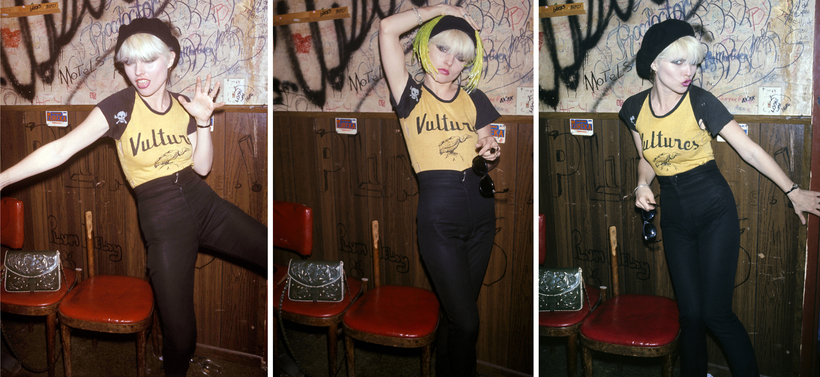Blondie wasn’t the artsiest band to hatch in the mid-1970s CBGB incubator; depending on your taste, that would have been Television, Talking Heads, or the Patti Smith Group. Blondie wasn’t the funniest band, either; to my taste, that would have been the Ramones. But Blondie was for sure the canniest band to emerge on the New York City scene in the mid-1970s, thanks in main to lead singer, songwriter, and front woman Debbie Harry.
Harry styled herself like a punk Marilyn Monroe, and belted out the group’s early, girl-group-inspired songs with winks, shrugs, and eye rolls, or sometimes an almost imperious hauteur. Previously, in rock, only boy acts like the New York Dolls and David Bowie had dared to camp it up like this. Harry’s stroke of genius was to reclaim the subversive glamour of showbiz drag for the girls. She and the boys in her band then backed up the attitude with great tunes and some smart covers, and garnered more Top 40 singles than the rest of their CBGB contemporaries combined. Madonna, Gwen Stefani, and Lady Gaga all owe Harry a debt, just as she does Cher.
Harry’s stroke of genius was to reclaim the subversive glamour of showbiz drag for the girls.
Now she’s written a memoir, Face It (with interviews conducted by Sylvie Simmons, a British rock journalist). Many people pass through these pages whom you’d expect to find—Bowie, Joey Ramone, Jean-Michel Basquiat, Andy Warhol, Fab 5 Freddy, David Johansen. There are also folks you might not expect, like Buddy Rich, the swing-era drummer who, she recalls, tried to pick up her and a cousin when they were 11 or 12 and vacationing on Cape Cod, or the wrestler Gorgeous George, a childhood hero of Harry’s whom she met sometime in the late 1960s while waiting tables as a Bunny at the New York Playboy Club.
Born to Be Wild
The book’s liveliest chapters recount Harry’s pre-fame life. We see her as a girl growing up in 1950s New Jersey, infatuated with TV, fashion, and the Emerald City calling seductively from across the Hudson. In high school—Class of ’63—she befriends a fellow detention-room habitué with a reputation as “the town pump” and cruises a local strip the kids call “Cunt Mile.” As she explains, “I really loved sex. I think I might have been oversexed, but I didn’t have a problem with that; I felt it was totally natural.” What felt unnatural was “the expectation for a girl that you would date, get engaged, remain a virgin, marry, and have children. The idea of being tied to that kind of traditional suburban life terrified me.”
Fortunately, she slipped that leash, crossing the river and, when not waitressing at the Playboy Club or Max’s Kansas City, moving into and out of a series of bands, relationships, and grubby downtown apartments. One group, the Stillettoes, eventually evolved into Blondie—named, in a fashion, after its front woman. “I had been bleaching my hair again and when I walked down the street the construction guys and truck drivers would yell, ‘Hey, Blondie!’ There was a famous comic strip character from the thirties named Blondie, a flapper—the dumb blonde who turns out to be smarter than the rest of them. Okay, I could play with that role onstage, it was a good start. But really there was no grand scheme behind anything. We just did what we liked to do and everything was just inching forward.”
“I really loved sex. I think I might have been oversexed, but … I felt it was totally natural.”
That matter-of-factness, an easy equanimity not typically associated with pop stars, pervades much of Face It, even when describing something as traumatic as a home-invasion rape and robbery at the apartment of her boyfriend and musical partner Chris Stein: “I can’t say that I felt a lot of fear. I’m very glad this happened pre-AIDS or I might have freaked. In the end, the stolen guitars hurt me more than the rape. I mean, we had no equipment. Chris had this tiny little amp that picked up the police radio signal and a bunch of white noise…. It seems absurd that we ever made it to be famous.”
I’m not sure Harry reveals much more about how fame finally did happen, or about the studio labors behind Blondie’s classic albums, than you could find in half an hour’s Googling. Perhaps she takes things more in stride than ardent fans might hope due to the fact that she was 33, more than old enough to be a has-been, when the band finally broke through, with its third LP, Parallel Lines, in 1978. She reports that she was reluctant even to write this book until she decided the time had come to “get it over with and remember.” Shrug. Eye roll. But she’s always good company, forthright if not analytic. She even has good things to say about heroin! Anyway, she concludes, “As I’ve learned in doing shows, it’s always best to leave the audience wanting more … ”
Bruce Handy is a journalist and the author of Wild Things: The Joy of Reading Children’s Literature as an Adult


